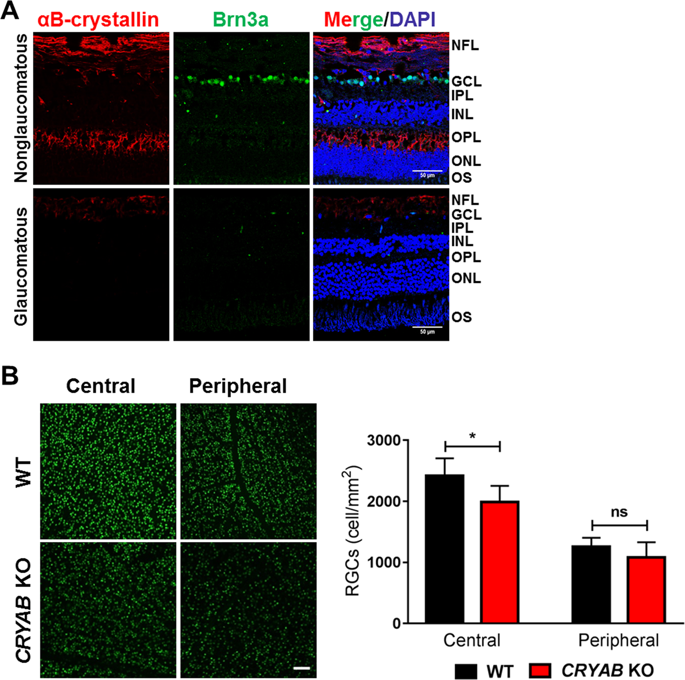Cell Death Discovery ( IF 7 ) Pub Date : 2019-07-04 , DOI: 10.1038/s41420-019-0194-2 Dorota L. Stankowska , Mi-Hyun Nam , Rooban B. Nahomi , Renuka M. Chaphalkar , Sandip K. Nandi , Rafal Fudala , Raghu R. Krishnamoorthy , Ram H. Nagaraj

|
Axonal degeneration and death of retinal ganglion cells (RGCs) are the primary causes of vision loss in glaucoma. In this study, we evaluated the efficacy of a peptide (peptain-1) that exhibits robust chaperone and anti-apoptotic activities against RGC loss in two rodent models and in cultured RGCs. In cultures of rat primary RGCs and in rat retinal explants peptain-1 significantly decreased hypoxia-induced RGC loss when compared to a scrambled peptide. Intraperitoneally (i.p.) injected peptain-1 (conjugated to a Cy7 fluorophore) was detected in the retina indicative of its ability to cross the blood-retinal barrier. Peptain-1 treatment inhibited RGC loss in the retina of mice subjected to ischemia/reperfusion (I/R) injury. A reduction in anterograde axonal transport was also ameliorated by peptain-1 treatment in the retina of I/R injured mice. Furthermore, i.p. injections of peptain-1 significantly reduced RGC death and axonal loss and partially restored retinal mitochondrial cytochrome c oxidase subunit 6b2 (COX 6b2) levels in rats subjected to five weeks of elevated intraocular pressure. We conclude that i.p. injected peptain-1 gains access to the retina and protects both RGC somas and axons against the injury caused by I/R and ocular hypertension. Based on these findings, peptain-1 has the potential to be developed as an efficacious neuroprotective agent for the treatment of glaucoma.
中文翻译:

在动物模型中全身施用peptain-1抑制视网膜神经节细胞死亡:对青光眼神经保护的影响
轴突变性和视网膜神经节细胞(RGCs)的死亡是青光眼视力丧失的主要原因。在这项研究中,我们评估了一种肽(peptain-1)的功效,该肽在两个啮齿动物模型和培养的RGC中均表现出强大的分子伴侣和抗凋亡活性,可防止RGC丢失。与扰乱的肽段相比,在大鼠原代RGC的培养物中和在大鼠视网膜外植体中,peptain-1显着降低了缺氧诱导的RGC损失。在视网膜中检测到腹膜内(ip)注射的peptain-1(与Cy7荧光团偶联),表明其穿过血视网膜屏障的能力。Peptain-1处理可抑制遭受缺血/再灌注(I / R)损伤的小鼠视网膜中RGC的损失。在I / R损伤的小鼠的视网膜中,peptain-1治疗也改善了顺行轴突运输的减少。此外,在经历五周眼压升高的大鼠中,腹膜内注射peptain-1可以显着降低RGC死亡和轴突丧失,并部分恢复视网膜线粒体细胞色素c氧化酶亚基6b2(COX 6b2)的水平。我们得出的结论是,腹膜内注射peptain-1可以进入视网膜,并且可以保护RGC体细胞和轴突免受I / R和高眼压所致的伤害。基于这些发现,peptain-1有潜力被开发为治疗青光眼的有效神经保护剂。注射的peptain-1可以进入视网膜,并保护RGC体细胞和轴突免受I / R和高眼压所致的伤害。基于这些发现,peptain-1有潜力被开发为治疗青光眼的有效神经保护剂。注射的peptain-1可以进入视网膜,并保护RGC体细胞和轴突免受I / R和高眼压所致的伤害。基于这些发现,peptain-1有潜力被开发为治疗青光眼的有效神经保护剂。



























 京公网安备 11010802027423号
京公网安备 11010802027423号